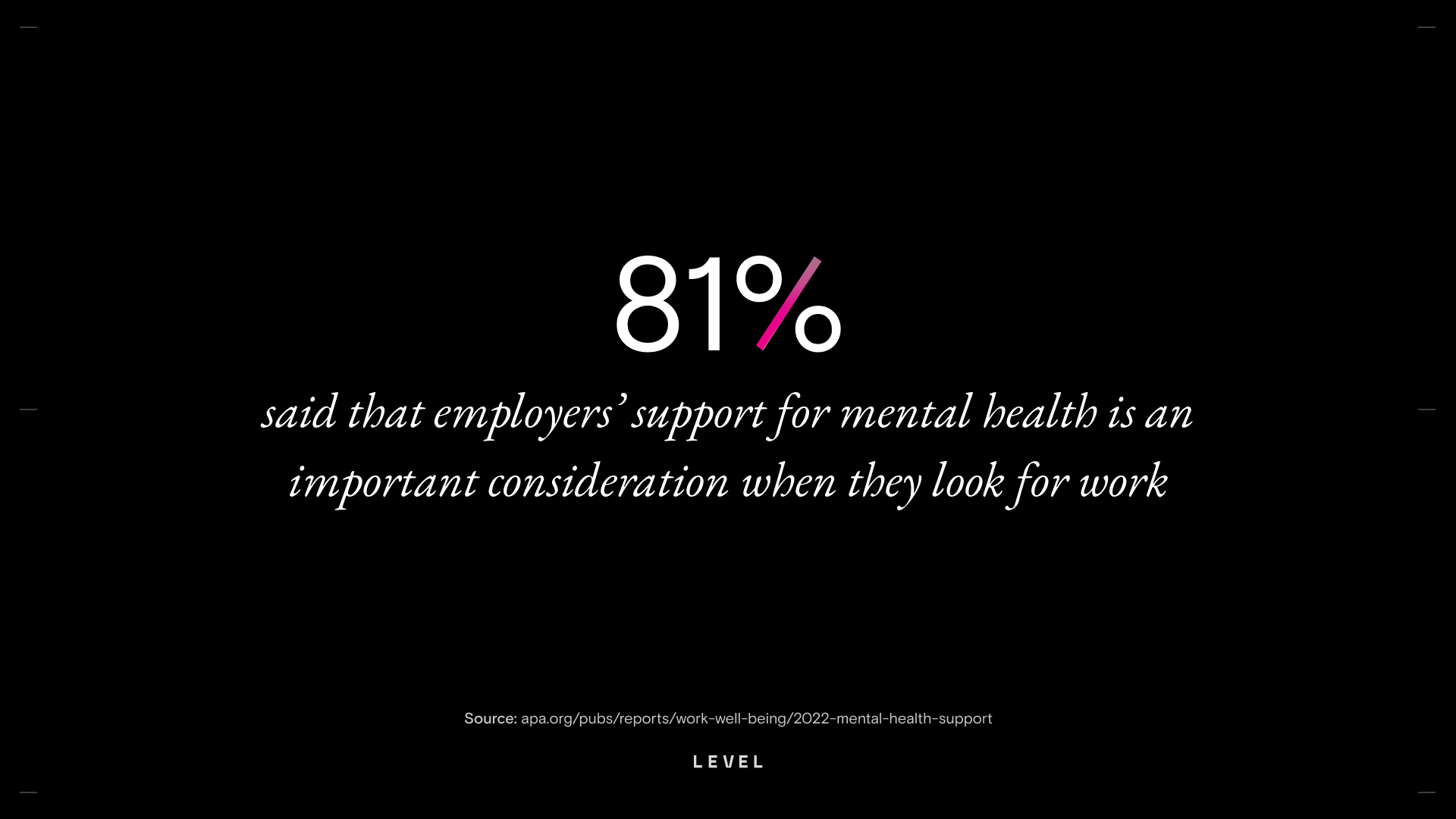Making Mental Health Benefits More Accessible and Inclusive: A True Story
May is Mental Health Awareness Month, a time when we might be reminded of our own experiences with mental health and accessing services. It’s unfortunate that for many with mental health challenges, the experience of trying to access care has been a struggle. Mental health awareness should compel us to think about access and inclusivity. If someone cannot access care, it doesn’t make a difference whether the care is world-class or not: it’s left unused. A person’s experience of accessing care is just as important as the quality of care itself.
Before we get to Level’s solution for making mental health benefits more accessible and inclusive, we want to bring the current struggles to life by sharing a story of one of Level’s own employees, Alyssa.

Alyssa’s struggle with Mental Health Access and Inclusivity
It’s common to encounter stigma surrounding mental health, especially within marginalized communities. For Alyssa, who identifies as BIPOC, the idea growing up was that seeing a therapist meant you were “crazy.” No surprise, then, that deciding to seek therapy brought about feelings of shame. It’s a tough hurdle to overcome, “but years later,” Alyssa says, “I can assure you that asking for help is one of the bravest things a person can do.” It’s true: we’re not crazy or broken, just humans navigating experiences of stress, anxiety, work transitions and relationships, and sometimes we all could use support.
Soon after she gave birth to twins during the pandemic, Alyssa returned to work with her former employer. This brought about tremendous worry, and would send her from fits of rage to bouts of sobbing. “I’m a bit of a perfectionist, but I was even harder on myself than usual, and would completely stall work projects if they didn’t meet my expectations.” Alyssa didn’t realize she was experiencing postpartum depression and anxiety. The experiences of these conditions can be masked and amplified by the day-to-day challenges of being a new parent. Alyssa and her partner found themselves “constantly tired, and couldn’t offer each other that extra space we needed.”
Alyssa had already been seeing a therapist before becoming a parent. Like many of us, therapy was made accessible through a health insurance provider or EAP benefit. But when her company changed their benefit provider, the bill went up to $150 per session. Compounding this struggle was the fact that her therapist was considered “out-of-network,” requiring her to pay for the services out of her own pocket before getting reimbursed. “With two new mouths to feed and diapers to buy, there was no way I could afford that.” She told her therapist she would call back to reschedule, and never did.
...when her company changed their benefit provider... her therapist was considered “out-of-network,” requiring her to pay for the services out of her own pocket... She told her therapist she would call back to reschedule, and never did.
“Asking for help, then not being able to afford it, is so frustrating,” she shared. So she tried searching for a therapist through apps which she admits “felt like going on blind dates—one therapist didn’t show up; another was kind enough, but therapy by text message didn’t feel like a good therapeutic relationship.”
For months, Alyssa felt hopeless, lost in the motions of daily life, frozen. She had called off the search for a therapist, but also had become completely unproductive, avoidant and generally irritable. Exhausted at home and at work, and on the way to burnout, she reached a breaking point and contemplated taking a leave of absence. And she’s not alone: 68% of Millennials and 81% of Gen-Zers have left roles for mental health reasons, up from 50% and 75% in 2019, respectively.

Alyssa re-opened the therapist search after starting at Level, where her job came with a benefits package more aligned to her needs. “That was a huge factor for me when joining.” In a recent survey, 81% of respondents said that employers’ support for mental health is an important consideration when they look for work.
“That was a huge factor for me when joining.”
She used an online platform that lets you filter mental health professionals by insurance, type of service (such as family or individual therapy), specialty or provider identity. “Being able to choose a provider who took my insurance, specialized in postpartum and parenting, was culturally competent and looked like me,” she says, “brought an immediate sense of relief.”

At her first session, she didn’t have to explain cultural context and how it related to the pressures of motherhood and work. “My therapist had the lived experience of being a part of the same culture and community.” It’s important to note here that, just because someone looks like you, that doesn’t mean they’ll be culturally competent.
Having access to mental health choices can make all the difference: 66% of workers who’ve considered quitting say access to mental health services might convince them to stay at a job. Because her new job offered better benefits, Alyssa could find a provider who took her insurance, she could afford the copay, and avoided a leave of absence.
Mental health awareness forces us to think about access and inclusivity. “At work, you bring your whole self, not just your skills,” she says. “And your identity and experience will dictate your output, because your joys, stress and worries don’t go away once you log on for the day.” Worldwide, lost productivity due to anxiety and depression costs $1 trillion per year. Access to decent benefits that support employee well-being fosters a culture of belonging, which in turn brings out our best work. In a global 2020 study of more than 11,800 employees, a sense of belonging emerged as the strongest driver of employee engagement – ahead of trust in leadership or potential career growth. Research shows that a company is more likely to achieve its goals when its people are engaged in their work. Belonging can be the difference between success and failure.

The Level Mental Health Accessibility Solution
At Level, a core belief is that intentional, accessible benefits are the most effective way to engage and drive company culture. In order to drive employee engagement, a company needs to invest in its employees’ health and well-being. And right now, access is an issue— some mental health professionals don’t take insurance, some insurances offer only partial reimbursement, and deductibles and copays vary.
That’s why at Level, we’ve created a solution to help employees access mental health services without the burden of having to afford upfront costs. Instead of reimbursement, Level helps companies offer employees a mental health allowance each year that is immediately accessible.
Imagine if your company announces that every employee will receive a card they can use to pay for mental health services, including out-of-network providers. You set up a weekly session with a therapist to talk about stress at work or home. You receive affirmation and tools to help you cope. Then you swipe your card, thank your therapist and say see you next week.
That’s how easy benefits should be. No processing time to verify insurance. No deductible. No copay. No out-of-pocket expense. That hour with your therapist is devoted solely to your mental health, so you can continue to bring your whole self to work, home, and every aspect of your life. That’s the biggest return on investment.
Contact our team to begin the conversation on how mental health benefits can amplify your company culture.




